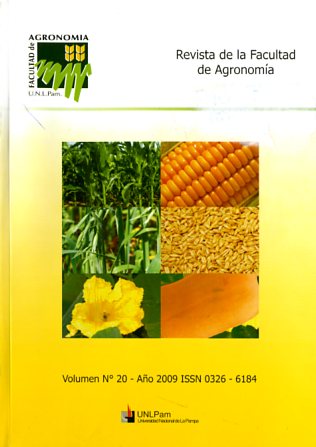Tillering and dry matter accumulation in individual plants of oat with different moments of defoliation
Keywords:
oat, early defoliation, tillering, dry matter accumulationAbstract
The objective of this study was to evaluate, at individual plant level, the effect of early defoliation on the dynamics of tillering and dry matter (O M) accumulation in oat (Avena byzantina e. Koch.) cv. Milagros INTA. The study was carried out at Santa Rosa (La Pampa, Argentina) during the 2007 growing season with oat seeds sowed on March 4. The treatments consisted of a control (without defoliation) and two initial defoliation times, and three harvest dates. The beginning of defoliation was established according the number of expanded leaves: three (early) and six (tillering). The experimental design was completely randomized with a factorial arrangement of treatments (defoliation x harvest date) and three replicates. Defoliation treatments were generated on April 5 (early) and on May 3 (tillering) by cuts to a height of 5 cm. The dynamics of tiller density and DM accumulation were evaluated in three dates: one early on June, and the other two with a 30 day frecuency. The tiller density and DM accumulation of individual oat plants with early defoliation and without defoliation showed a similar pattern (p>0.05). On contrary, plants with late defoliation showed lower values (p<0.05) in both variables. Under the condition of this study, it is possible to conclude that early defoliation did not promote neither tillering nor dry matter accumulation, in tillering both variables get depressed.Downloads
References
Amigone, MA & A.M. Kloster. 1997. Verdeas de invierno. In: N.J. Latimori & A.M. Kloster (eds.). Invernada bovina en zonas mixtas. Agro 2 Córdoba. INTA, Centro Regional Córdoba. pp. 38-56.
Amigone, M.A. & J.C. Tomaso. 2008. Principales características de especies y cultivares de verdeas invernales. http://www.inta.gov.ar (Consultado el23 de Setiembre de 2009).
Briske, D.D. 1991. Developmental morphology and physiology of grasses. en: RK. Heitschmidt & Stuth (eds.). Grazing management: An ecological perspective. Timber Press, Portland, OR, USA, pp. 85-108.
Brizuela, M.A.; A. Alasia & M.S. Cid. 2006. Macollamiento de dos cultivares de avena con y sin defoliación temprana. Rev. Arg. Prod. Anim.26:229-230.
Brizuela, MA & M.S. Cid. 2008. Defoliación temprana y macollamiento en dos cultivares de avena. Rev. Arg. Prod. Anim. 28: 349-353.
Casal, J.J.; VA Deregibus & RA. Sánchez 1985. Variations in tiller dynamics and morphology in Lolium perenne Lam. vegetative and reproductive plants as affected by red/far-red radiation. Ann. Bot 56: 553-559.
Davies, A. 1988. The regrowth of grass swards. en: M.B. Jones & A. Lazenby (eds.). The grass crop. Chapman Hall, London, UK. pp. 85-127.
INDEC. 2002. Encuesta Nacional Agropecuaria 2002. Instituto Nacional de Estadística y Censos. http://www.indec.gov.ar (Consultado el 23 de Setiembre de 2009).
Lemaire G. & D. Chapman. 1996. Tissue flows in grazed plant communities. In: J. Hodgson & A.W. IIlius (eds.). The ecology and management of grazing systems. CAB International, Wallingford, UK. pp. 3-36.
Méndez, D.G. & P. Davies. 2000. Actualización en utilización de verdeas invernales. Publicación Técnica N° 30. Secretaría de Agricultura, Ganadería y Pesca. INTA, EEA General Villegas, 37 p.
Rodríguez Elizagaray, M.; F. Giannitti; E. Odriozola & P. Alvarado. 2007. Manejo alternativo de verdeas de avena: respuesta productiva del forraje al pastoreo precoz. Rev. Arg. Prod. Anim. 27:129-130.
Sonego, M.; D.J. Moot; P.D. Jamieson; RJ. Martin & W.R Scout. 2000. Apical development in oats predicted by leaf stage. Field Crops Res. 65: 79-86.
Downloads
Published
Issue
Section
License
La Editorial de la Universidad Nacional de La Pampa (EdUNLPam) exigirá a los/as autores/as la firma del siguiente documento:
La EdUNLPam lleva a cabo la publicación del artículo: (Título del Artículo) en SEMIÁRIDA Rev.Fac.Agron UNLPam ISSN 2362-4337 (impresa) ISSN 2408-4077 (en línea), del cual el/los abajo firmantes son autores de una o más partes. En el mismo acto, el/los autores entregan exclusivamente a la EdUNLPam todos sus derechos protegidos por las leyes de propiedad intelectual que rigen en la Argentina para reproducir, publicar, editar, fijar, comunicar y transmitir públicamente en cualquier formato o medio impreso o electrónico, inclusive internet, el artículo enviado a publicación e incluirlo en índices o bases de datos nacionales e internacionales. A cambio, la EdUNLPam entrega a los autores la autorización para la publicación o reimpresión con ines académicos y educativos en cualquier libro o medio de divulgación, con la sola obligación de citar el artículo original publicado en la EdUNLPam. Cada autor acuerda en que el material provisto a la EdUNLPam es un trabajo original, que no ha sido impreso o publicado en cualquier otro medio con anterioridad y que no vulnera derechos de terceros. El Primer autor tendrá la posibilidad de leer y corregir el artículo ya editado como “prueba de galera”, pero si el autor no devolviera esas correcciones de la prueba de galera dentro del tiempo especificado, el proceso de producción y publicación podrá proseguir sin la aprobación del autor. El/los autor/es no recibirán compensación monetaria de la EdUNLPam por el uso del material contenido en este artículo y asumen la responsabilidad de las opiniones vertidas en él.






.png)



22.png)



.jpg)




.jpg)
